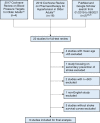Time to benefit for stroke reduction after blood pressure treatment in older adults: A meta-analysis
- PMID: 35137952
- PMCID: PMC9106841
- DOI: 10.1111/jgs.17684
Time to benefit for stroke reduction after blood pressure treatment in older adults: A meta-analysis
Abstract
Background: Hypertension treatment in older adults can decrease mortality, cardiovascular events, including heart failure, cognitive impairment, and stroke risk, but may also lead to harms such as syncope and falls. Guidelines recommend targeting preventive interventions with immediate harms and delayed benefits to patients whose life expectancy exceeds the intervention's time to benefit (TTB). Our objective was to estimate a meta-analyzed TTB for stroke prevention after initiation of more intensive hypertension treatment in adults aged ≥65 years.
Methods: Studies were identified from two Cochrane systematic reviews and a search of MEDLINE and Google Scholar for subsequent publications until August 31, 2021. We abstracted data from randomized controlled trials comparing standard (untreated, placebo, or less intensive treatment) to more intensive treatment groups in older adults (mean age ≥ 65 years). We fit Weibull survival curves and used a random-effects model to estimate the pooled annual absolute risk reduction (ARR) between control and intervention groups. We applied Markov chain Monte Carlo methods to determine the time to ARR thresholds (0.002, 0.005, and 0.01) for a first stroke.
Results: Nine trials (n = 38,779) were identified. The mean age ranged from 66 to 84 years and study follow-up times ranged from 2.0 to 5.8 years. We determined that 1.7 (95%CI: 1.0-2.9) years were required to prevent 1 stroke for 200 persons (ARR = 0.005) receiving more intensive hypertensive treatment. Heterogeneity was found across studies, with those focusing on tighter systolic blood pressure control (SBP < 150 mmHg) showing longer TTB. For example, in the SPRINT study (baseline SBP = 140 mmHg, achieved SBP = 121 mmHg), the TTB to avoid 1 stroke for 200 patients treated was 5.9 years (95%CI: 2.2-13.0).
Conclusions: More intensive hypertension treatment in 200 older adults prevents 1 stroke after 1.7 years. Given the heterogeneity across studies, the TTB estimates from individual studies may be more relevant for clinical decision-making than our summary estimate.
Keywords: hypertension; stroke; time to benefit.
© 2022 The American Geriatrics Society. This article has been contributed to by US Government employees and their work is in the public domain in the USA.
Conflict of interest statement
The author declares that there is no conflict of interest.
Figures



Comment in
-
The time to benefit from intensive hypertensive control is now.J Am Geriatr Soc. 2022 May;70(5):1355-1357. doi: 10.1111/jgs.17729. Epub 2022 Mar 22. J Am Geriatr Soc. 2022. PMID: 35315514 No abstract available.
Similar articles
-
Evaluation of Time to Benefit of Statins for the Primary Prevention of Cardiovascular Events in Adults Aged 50 to 75 Years: A Meta-analysis.JAMA Intern Med. 2021 Feb 1;181(2):179-185. doi: 10.1001/jamainternmed.2020.6084. JAMA Intern Med. 2021. PMID: 33196766 Free PMC article. Review.
-
Time to Clinical Benefit of Intensive Blood Pressure Lowering in Patients 60 Years and Older With Hypertension: A Secondary Analysis of Randomized Clinical Trials.JAMA Intern Med. 2022 Jun 1;182(6):660-667. doi: 10.1001/jamainternmed.2022.1657. JAMA Intern Med. 2022. PMID: 35532917 Free PMC article.
-
Effects of blood pressure-lowering treatment on cardiovascular outcomes and mortality: 13 - benefits and adverse events in older and younger patients with hypertension: overview, meta-analyses and meta-regression analyses of randomized trials.J Hypertens. 2018 Aug;36(8):1622-1636. doi: 10.1097/HJH.0000000000001787. J Hypertens. 2018. PMID: 29847485 Review.
-
Benefit and harm of intensive blood pressure treatment: Derivation and validation of risk models using data from the SPRINT and ACCORD trials.PLoS Med. 2017 Oct 17;14(10):e1002410. doi: 10.1371/journal.pmed.1002410. eCollection 2017 Oct. PLoS Med. 2017. PMID: 29040268 Free PMC article. Clinical Trial.
-
Potential Deaths Averted and Serious Adverse Events Incurred From Adoption of the SPRINT (Systolic Blood Pressure Intervention Trial) Intensive Blood Pressure Regimen in the United States: Projections From NHANES (National Health and Nutrition Examination Survey).Circulation. 2017 Apr 25;135(17):1617-1628. doi: 10.1161/CIRCULATIONAHA.116.025322. Epub 2017 Feb 13. Circulation. 2017. PMID: 28193605 Free PMC article.
Cited by
-
Optimal Blood Pressure Targets with Age.Clin Geriatr Med. 2024 Nov;40(4):585-595. doi: 10.1016/j.cger.2024.04.002. Epub 2024 May 10. Clin Geriatr Med. 2024. PMID: 39349033 Review.
-
Evidence for Age Bias Contributing to Therapeutic Inertia in Blood Pressure Management: A Secondary Analysis of SPRINT.Hypertension. 2023 Jul;80(7):1484-1493. doi: 10.1161/HYPERTENSIONAHA.123.21323. Epub 2023 May 11. Hypertension. 2023. PMID: 37165900 Free PMC article. Clinical Trial.
-
Time to Benefit of Surgery vs Targeted Medical Therapy for Patients With Primary Aldosteronism: A Meta-analysis.J Clin Endocrinol Metab. 2024 Feb 20;109(3):e1280-e1289. doi: 10.1210/clinem/dgad654. J Clin Endocrinol Metab. 2024. PMID: 37946600 Free PMC article.
-
We have the technology: Why aren't better blood pressure data available from nursing home residents?J Am Geriatr Soc. 2023 Jul;71(7):2046-2048. doi: 10.1111/jgs.18389. Epub 2023 Apr 28. J Am Geriatr Soc. 2023. PMID: 37114862 Free PMC article. No abstract available.
-
The Impact of Aerobic Exercise on Health Management in Older Patients with Hypertension: A Systematic Review of Randomized Controlled Trials from the Past Decade.Int J Gen Med. 2025 Jun 3;18:2823-2838. doi: 10.2147/IJGM.S516371. eCollection 2025. Int J Gen Med. 2025. PMID: 40487982 Free PMC article. Review.
References
-
- Centers for Disease Control and Prevention (CDC) . Estimated Hypertension Prevalence, Treatment, and Control Among U.S. Adults Tables. Million Hearts website. https://millionhearts.hhs.gov/data-reports/hypertension-prevalence-table.... Updated March 22, 2021. Accessed June 2, 2021.
-
- National Center for Health Statistics, Centers for Disease Control and Prevention . National Health and nutrition examination survey (NHANES), 2015–2018.
Publication types
MeSH terms
Substances
Grants and funding
LinkOut - more resources
Full Text Sources
Medical

